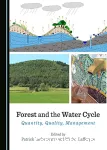| Titre : | Forest and the Water Cycle : quantity, quality, Management |
| Auteurs : | Patrick Lachassagne, Auteur ; Michel Lafforgue, Auteur |
| Type de document : | texte imprimé |
| Editeur : | Newcastle upon Tyne [United Kingdom] : Cambridge Scholars Publishing, 2016 |
| ISBN/ISSN/EAN : | 978-1-4438-8825-7 |
| Format : | 654 pages |
| Langues: | Anglais |
| Index. décimale : | Eau-Energie |
| Catégories : |
[Archirès ] 030 Paysage - environnement > Environnement > Eau > Assainissement [Archirès ] 030 Paysage - environnement > Environnement > Eau > Gestion de l'eau [Archirès ] 072 Économie > Économie > Secteur d'activité économique > Agriculture > Sylviculture |
| Résumé : |
Are forests beneficial or prejudicial to the functions and uses of water? Is it possible to concomitantly sustain forestry activities and to protect downstream water uses, particularly drinking water supply? For most scientists and practitioners, but also for a wider audience, woodland areas benefit from a very positive image. In fact, they often maintain or improve the quality of water resources, in addition to benefits for biodiversity, landscapes, and recreational activities, among others. Regarding the quantitative aspect of water resources, the issue is more often discussed with positive arguments for less runoff, and less floods and erosion, but also a decrease of water resource availability due to the higher evapotranspiration of forests in comparison with other landcovers.
In order to answer these issues, and as a result of the LIFE+ SEMEAU Project and International Conference, the book brings together international contributions from the forestry and water resource communities, including scientists, consultants, managers, operators, and project owners, from the point of view of a scientific approach, as well as a regulatory and socio-economic perspective, and both from Drinking Water and Natural Mineral Water standpoints. The book will also contribute to facilitating dialogue between foresters and those responsible for managing water resources, and making protective actions for water resources in forested areas simpler, more efficient and proactive. To this end, it comprises 32 different original contributions with about 50 co-authors, structured in seven parts. The introductory chapters have been specifically drafted to provide forestry and water professionals with a shared base of hydrological and forestry language. The book also includes a number of case studies in various countries, to properly illustrate the subjects under consideration. |
Exemplaires (1)
| Code-barres | Cote | Support | Localisation | Section | Disponibilité |
|---|---|---|---|---|---|
| 04833 | K.03/LAC | Livres | CENTRE DE DOCUMENTATION | Salle de consultation | Disponible |



